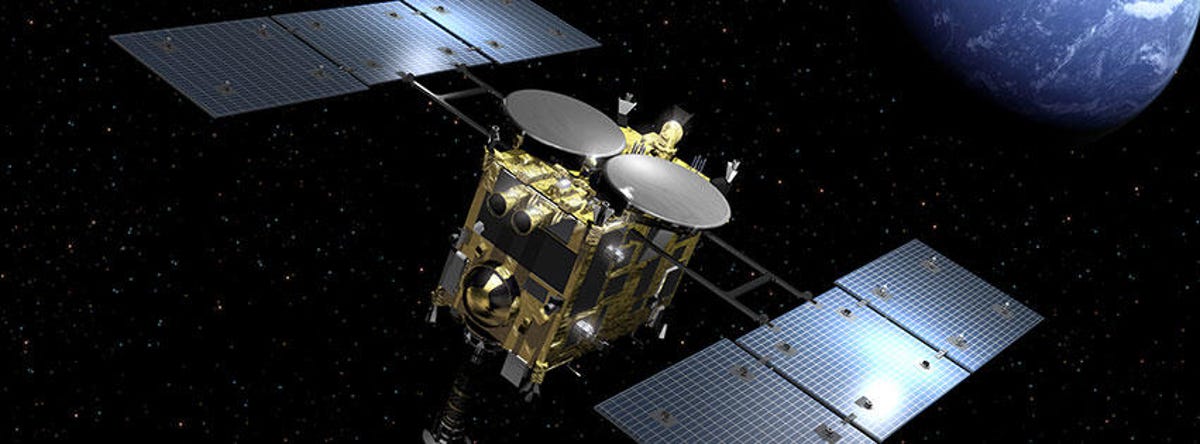Explore asteroid Ryugu with Japan's Hayabusa 2 spacecraft
A JAXA spacecraft and a gaggle of daring rovers and landers are investigating a rocky, alien asteroid world.

Hayabusa 2
JAXA's Hayabusa 2 mission is one of the most ambitious in the history of asteroid research. The Japanese space agency's craft is currently hanging out with an asteroid named Ryugu. Not content to just observe, the spacecraft already deposited two rovers and a lander the space rock's surface.
JAXA plans to have Hayabusa 2 gather a sample of Ryugu and bring it back to Earth in late 2020. The spacecraft is a sequel to the original Hayabusa mission, which returned a tiny bit of an asteroid back in 2010.
This illustration shows Hayabusa 2 in space.
Ryugu as seen by Hayabusa 2
Ryugu's official name is 1999 JU3. It's classified as a potentially hazardous asteroid since its travel path brings it into Earth's neighborhood, even though it currently poses no threat to us.
Ryugu refers to the name of a dragon's undersea palace from Japanese folklore. Hayabusa 2's imagery of the asteroid from its approach in June shows a space rock with a gemstone-like shape.
Ryugu surface close-up
Hayabusa 2 snapped this image from a distance of just 3,280 feet (1,000 meters). It shows the rugged and rocky surface of Ryugu.
Minerva rovers investigate Ryugu
JAXA's Hayabusa 2 team successfully landed two tiny Minerva rovers, called 1A and 1B, on the asteroid in September. The rovers are designed to get around by hopping, rather than rolling.
This eye-catching image comes from rover 1A on Sept. 22 during a hop. The bright glow on the right is from sunlight while the asteroid's surface appears on the left.
Hayabusa 2 sees its shadow
Hayabusa 2 captured this image of its own shadow as it moved in close to Ryugu to drop off the Minerva rovers in September.
Minerva rovers before launch
The two small Minerva rovers pose with the housing that shielded them onboard Hayabusa 2. Both rovers successfully reached the surface of asteroid Ryugu in September. One even sent back a short movie taken on the asteroid.
Rover snaps a selfie
Minerva Rover-1A took a selfie of sorts on the surface of Ryugu on Sept. 23. JAXA points out the rover's antenna and pin as they appear in shadowy form against the asteroid's rocky surface.
Ryugu in high-res
Hayabusa 2 got a great shot of the asteroid's surface when it closed in on Ryugu in order to drop off the Minerva rovers in September. This image shows off the asteroid's rocky, boulder-strewn landscape and is the highest-resolution view released yet.
Rover gets a surface shot
Minerva rover 1B got a close-up look at Ryugu's inhospitable-looking surface on Sept. 23, just before it hopped into a new position.
Mascot lander before launch
The Minerva rovers weren't Hayabusa 2's only emissaries to the asteroid. The Mascot lander, developed by the German Aerospace Center (DLR) and French space agency CNES, touched down on Ryugu in early October.
Mascot is the light-colored, box-shaped machine tucked into its mount on Hayabusa 2 in this photo.
Mascot lander heads for Ryugu
Hayabusa 2 caught sight of the Mascot (Mobile Asteroid Surface Scout) lander on its way down to asteroid Ryugu on Oct. 3. The box-like object in this image is the lander shortly after separation from the spacecraft.
Hayabusa 2 sidled up near the asteroid in order to deploy Mascot. Mascot successfully operated for over 16 hours on battery power. It took images of the surface and studied the asteroid's temperature and magnetic field.
Mascot sees Ryugu
The Mascot lander took its own pictures of Ryugu, including this shot while it was landing. The Mascot team described the asteroid as a "land full of wonder, mystery and danger."

